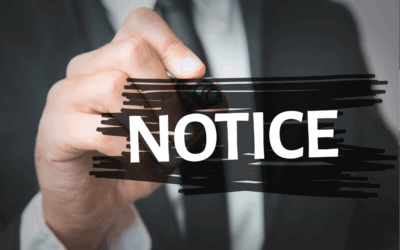If you are a plan sponsor (or you’ve read Part 1 of this guide), you know that you are responsible for overseeing retirement plans (such as 401(k)s or pensions). As such, you must also provide participants with various notices throughout the year. These notices ensure compliance with regulatory requirements and inform 401(k) participants of their rights and plan details.
Managing roughly 15 types of notices demands strong organization and clear internal communication to ensure accurate, on-time delivery. To help you stay ahead of any potential confusion, our team at Watkins Ross has shared some best practices for issuing participant notices.
1. Plan Sponsor Responsibilities: Understand Regulatory Requirements
Plan sponsors need to be aware of the various notices required under both federal and state law. These include but are not limited to:
- Summary Plan Description (SPD)
- Automatic Enrollment Notices
- Qualified Default Investment Alternative (QDIA) Notice
- Safe Harbor Notices (if applicable)
- 404a-5 Fee Disclosure Notices
- Annual 404c Notice (for plans offering participant-directed investments)
- 401(k) Safe Harbor Notice (if applicable)
- Retirement Plan Blackout Period Notice
- Required Minimum Distribution (RMD) Notices (for participants nearing retirement age)
You can find a more detailed version of this list in Part 1 of this guide.
2. Plan Sponsor Best Practices: Provide Clear, Concise, Understandable Notices
Clear communication builds trust and reduces confusion.
Keep it simple and transparent. Notices should be written in plain language that 401(k) participants can easily understand. Avoid using legal jargon or technical language unless absolutely necessary. The goal is to ensure participants can make informed decisions about their retirement plans.
Deliver notices on time. Notices must be provided within specific timeframes. For example, the 404a-5 Fee Disclosure Notice must be sent at least once per year, and the QDIA notice must be sent at least 30 days but not more than 60 days before the plan’s automatic enrollment takes effect.
3. Plan Sponsor Strategies: Use Multiple Delivery Methods
There are three primary delivery methods available. Consider when to use each:
Electronic Delivery (preferred): When possible, plan sponsors can take advantage of electronic delivery, as it’s efficient and cost-effective. However, the plan sponsor must ensure that 401(k) participants consent to electronic delivery, and the notices must be accessible and easily printable.
Paper Copies: Participants who opt-out of electronic delivery or don’t provide an email address should receive paper copies. Make sure to use reliable mailing practices to confirm delivery.
Ensure Confirmation: For key notices, such as those related to a blackout period or plan changes, obtaining proof of delivery (e.g., return receipt for mailed notices or read receipt for emails) can help ensure that participants received the information.
4. Plan Sponsor Compliance: Stay Ahead of Deadlines
Proactive planning keeps you compliant.
Track key dates: Ensure the deadlines for notices are tracked and met. Use tools like calendar reminders, automated systems, or third-party record-keepers to help.
Provide notices early: If a notice must be delivered by a certain date, plan sponsors should err on the side of caution. Send the notices earlier than the deadline, particularly in cases where they rely on postal delivery.
5. Maintain Records of Notices
Good records protect you during audits.
Document and keep an audit trail: Keep thorough records of all notices sent, including when and how they were delivered. This will be essential in case of Department of Labor (DOL) or the Internal Revenue Service (IRS) audits and will help ensure compliance.
Confirm compliance with ERISA: The Employee Retirement Income Security Act (ERISA) mandates that certain documents be made available to plan participants. Maintaining proof of proper delivery (both electronic and paper) helps demonstrate compliance with ERISA’s disclosure rules.
6. Be Transparent About Fees and Investments
Transparency empowers informed decisions.
Disclose fees: Under Section 404a-5 of ERISA, plan sponsors must provide annual disclosures of investment options, associated fees, and other related expenses to plan 401(k) participants. This helps participants make informed decisions about where to invest.
Provide investment performance data: While it’s not always mandatory, providing participants with investment performance data and comparative benchmarks can be helpful and improve participant engagement.
7. Provide Relevant Information at Key Times
Timely updates keep participants prepared.
Provide notice of plan changes: If there are any plan amendments, changes to investment options, or alterations to features (such as a change to automatic enrollment), ensure participants are notified well in advance.
Provide notice of plan blackouts: If there will be a blackout period (e.g., when plan transactions are temporarily unavailable due to system updates or plan mergers), participants must be notified at least 30 days in advance. The notice must specify the duration of the blackout period.
8. Make Notices Accessible to all Participants
Accessibility ensures compliance and boosts participation.
Consider diverse needs: Ensure that all participants, including those with disabilities, can access the notices. For example, notices should be in an accessible format, such as large print or screen reader-compatible versions, if needed.
Language accessibility: If you have participants for whom English is not their first language, consider providing notices in multiple languages. This ensures broader comprehension and compliance.
9. Promote Financial Education
Education drives engagement and confidence.
Offer educational resources: Along with the required notices, plan sponsors can provide educational materials to help 401(k) participants understand their retirement plan options, the investment choices available, and how to maximize their benefits. This can include webinars, workshops, or one-on-one consultations.
Offer financial wellness programs: Consider incorporating financial wellness programs or resources that support broader retirement and financial planning. This helps participants feel more confident in making decisions.
10. Review and Update Notices Regularly
Regular reviews keep information accurate.
Review notices annually: At least once a year, the plan sponsor should review all required notices to ensure they reflect current plan provisions and comply with any changes in federal or state law.
Stay updated on regulatory changes: Regularly check for updates to regulations from the Department of Labor (DOL), the IRS, and other governing bodies that may impact your notice requirements.
11. Ensure a User-Friendly Format
User-friendly formats increase retention.
Simplify notices: Rather than overwhelming participants with long or complex documents, use summaries, bullet points, and highlights. Present key information clearly and in an easy-to-digest format.
Ensure access via plan website: Post notices on the plan’s participant website or portal for easy access. Ensure the site is user-friendly and provides quick links to important documents.
12. Seek Professional Guidance as Needed
Expert help keeps your plan on track.
Work with advisors or Third-Party Administrators: Retirement plan regulations can be complex and subject to change. Collaborating with a retirement plan advisor or third-party administrator (TPA) ensures that all notices meet regulatory standards and are distributed appropriately.
Stay informed: Stay on top of changes in laws and regulations regarding retirement plans by regularly attending webinars, reading industry publications, or consulting legal advisors.
Don’t Miss Part 3
By following these best practices, plan sponsors can ensure they meet their legal obligations and foster 401(k) participant engagement. Most importantly, use this guide to help participants make more informed decisions about their retirement planning.
In Part 3 of our guide, we will take a closer look at the legal, financial, and operational risks associated with failing to provide required notices and disclosures.
If you have any questions about notices and disclosures, please feel free to contact us at 616-456-9696. Or, send us a message online.



